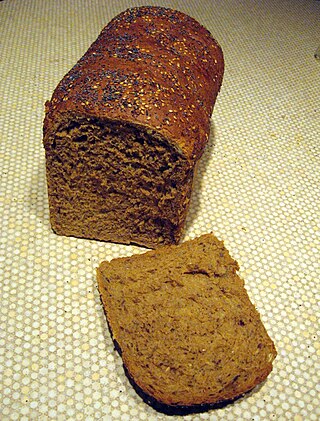
Bread is a staple food prepared from a dough of flour and water, usually by baking. Throughout recorded history and around the world, it has been an important part of many cultures' diet. It is one of the oldest human-made foods, having been of significance since the dawn of agriculture, and plays an essential role in both religious rituals and secular culture.

A croissant is a French pastry made from puff pastry in a crescent shape.

Sourdough or sourdough bread is a bread made by the fermentation of dough using wild lactobacillaceae and yeast. Lactic acid from fermentation imparts a sour taste and improves keeping qualities.

Dough is a thick, malleable, sometimes elastic paste made from grains or from leguminous or chestnut crops. Dough is typically made by mixing flour with a small amount of water or other liquid and sometimes includes yeast or other leavening agents, as well as ingredients such as fats or flavourings.

Breadcrumbs, also known as breading, consist of crumbled bread of various dryness, sometimes with seasonings added, used for breading or crumbing foods, topping casseroles, stuffing poultry, thickening stews, adding inexpensive bulk to soups, meatloaves and similar foods, and making a crisp and crunchy covering for fried foods, especially breaded cutlets like tonkatsu and schnitzel. The Japanese variety of breadcrumbs is called "panko".

Ciabatta is an Italian white bread created in 1982 by a baker in Adria, province of Rovigo, Veneto, in response to the popularity of French baguettes. Ciabatta is somewhat elongated, broad, and flat, and is baked in many variations, although unique for its alveolar holes. Ciabatta is made with a strong flour and uses a very high hydration dough.

Quick bread is any bread leavened with a chemical leavening agent rather than a biological one like yeast or sourdough starter. An advantage of quick breads is their ability to be prepared quickly and reliably, without requiring the time-consuming skilled labor and the climate control needed for traditional yeast breads.

Rye bread is a type of bread made with various proportions of flour from rye grain. It can be light or dark in color, depending on the type of flour used and the addition of coloring agents, and is typically denser than bread made from wheat flour. Compared to white bread, it is higher in fiber, darker in color, and stronger in flavor. The world's largest exporter of rye bread is Poland.

A ferment is a fermentation starter used in indirect methods of bread making. It may also be called mother dough.
The Chorleywood bread process (CBP) is a method of efficient dough production to make yeasted bread quickly, producing a soft, fluffy loaf. Compared to traditional bread-making processes, CBP uses more yeast, added fats, chemicals, and high-speed mixing to allow the dough to be made with lower-protein wheat, and produces bread in a shorter time. It was developed by Bill Collins, George Elton and Norman Chamberlain of the British Baking Industries Research Association at Chorleywood in 1961. As of 2009, 80% of bread made in the United Kingdom used the process.

In cooking, proofing is a step in the preparation of yeast bread and other baked goods in which the dough is allowed to rest and rise a final time before baking. During this rest period, yeast ferments the dough and produces gases, thereby leavening the dough.

Akki rotti or akki roti is an Indian flatbread made from rice flour. It is a part of Karnataka cuisine.

A dough conditioner, flour treatment agent, improving agent or bread improver is any ingredient or chemical added to bread dough to strengthen its texture or otherwise improve it in some way. Dough conditioners may include enzymes, yeast nutrients, mineral salts, oxidants and reductants, bleaching agents and emulsifiers. They are food additives combined with flour to improve baking functionality. Flour treatment agents are used to increase the speed of dough rising and to improve the strength and workability of the dough.

Bread was central to the formation of early human societies. From the Fertile Crescent, where wheat was domesticated, cultivation spread north and west, to Europe and North Africa, and east toward East Asia. This in turn led to the formation of towns, which curtailed nomadic lifestyles, and gave rise to more and more sophisticated forms of societal organization. Similar developments occurred in the Americas with maize and in Asia with rice.

Tandoor bread refers to a bread baked in a clay oven called a tandoor.

No-knead bread is a method of bread baking that uses a very long fermentation (rising) time instead of kneading to form the gluten strands that give the bread its texture. It is characterized by a low yeast content and a very wet dough.

Multigrain bread is a type of bread prepared with two or more types of grain. Grains used include barley, flax, millet, oats, wheat, and whole-wheat flour, among others. Some varieties include edible seeds in their preparation, such as flaxseed, quinoa, pumpkin seeds, and sunflower seeds. Rye and sourdough multigrain breads are additional varieties. Preparations include 7-grain and 9-grain bread, among others.
















